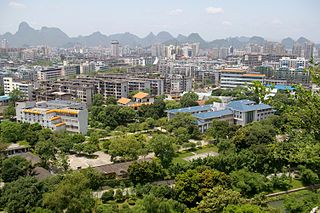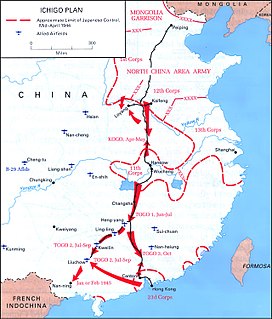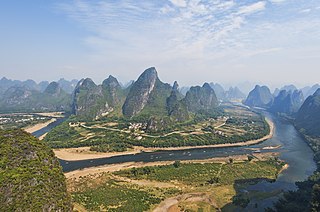
The Sino-French War, also known as the Tonkin War and Tonquin War, was a limited conflict fought from August 1884 through April 1885, to decide whether France would supplant China's control of Tonkin. Although the Chinese armies performed better than in other nineteenth-century wars and the war ended with French defeat on land, the French achieved most of their aims in the Treaty of Tientsin.

Li Zongren or Li Tsung-jen, courtesy name Delin, was a prominent Guangxi warlord and Kuomintang (KMT) military commander during the Northern Expedition, Second Sino-Japanese War and Chinese Civil War. He served as vice-president and acting President of the Republic of China under the 1947 Constitution.

Bai Chongxi was a Chinese general in the National Revolutionary Army of the Republic of China (ROC) and a prominent Chinese Nationalist leader. He was of Hui ethnicity and of the Muslim faith. From the mid-1920s to 1949, Bai and his close ally Li Zongren ruled Guangxi province as regional warlords with their own troops and considerable political autonomy. His relationship with Chiang Kai-shek was at various times antagonistic and cooperative. He and Li Zongren supported the anti-Chiang warlord alliance in the Central Plains War in 1930, then supported Chiang in the Second Sino-Japanese War and the Chinese Civil War. Bai was the first defense minister of the Republic of China from 1946-48. After losing to the Communists in 1949, he fled to Taiwan, where he died in 1966.

Guilin, alternately romanized as Kweilin, is a prefecture-level city in the northeast of China's Guangxi Zhuang Autonomous Region. It is situated on the west bank of the Li River and borders Hunan to the north. Its name means "Forest of Sweet Osmanthus", owing to the large number of fragrant sweet osmanthus trees located in the region. The city has long been renowned for its scenery of karst topography.

The Battle of Changsha (1944) was an invasion of the Chinese province of Hunan by Japanese troops near the end of the Second Sino-Japanese War. As such, it encompasses three separate conflicts: an invasion of the city of Changsha and two invasions of Hengyang.

Liuzhou is a prefecture-level city in north-central Guangxi Zhuang Autonomous Region, People's Republic of China. The prefecture's population was 3,758,700 in 2010, including 1,436,599 in the built-up area made of 4 urban districts. Its total area is 18,777 km2 (7,250 sq mi) and 667 km2 (258 sq mi) for built up area.

Operation Ichi-Go was a campaign of a series of major battles between the Imperial Japanese Army forces and the National Revolutionary Army of the Republic of China, fought from April to December 1944. It consisted of three separate battles in the Chinese provinces of Henan, Hunan and Guangxi.
The Battle of West Hunan, also known as the Battle of Xuefeng Mountains and the Zhijiang Campaign, was the Japanese invasion of west Hunan and the subsequent Allied counterattack that occurred between 6 April and 7 June 1945, during the last months of the Second Sino-Japanese War. Japanese strategic aims for this campaign were to seize Chinese airfields and secure railroads in West Hunan, and to achieve a decisive victory that their depleted land forces needed.
The Battle of Guilin–Liuzhou, also known as the Battle of Guiliu, was one of the 22 major engagements between the National Revolutionary Army (NRA) and Imperial Japanese Army (IJA) during the Second Sino-Japanese War.

Guangxi University, known as Xida, is a provincial research university located in Nanning, Guangxi and the oldest and largest university in the Guangxi Zhuang Autonomous Region. The university helped pioneer higher education in central and southwestern China, where its faculty, students, and resources contributed to the creation of over 20 universities and academic departments during the mid 20th century. The university grants bachelor's, master's, and doctoral degrees across 27 colleges and departments and 98 undergraduate majors.
The Battle of South Guangxi was one of the 22 major engagements between the National Revolutionary Army and Imperial Japanese Army during the Second Sino-Japanese War.

Zhang FakuiCBE was a Chinese Nationalist general who fought against northern warlords, the Imperial Japanese Army and Chinese Communist forces in his military career. He served as commander-in-chief of the 8th Army Group and commander-in-chief of NRA ground force before retiring in Hong Kong in 1949.
The Battle of Kunlun Pass was a series of conflicts between the Imperial Japanese Army and the Chinese forces surrounding Kunlun Pass, a key strategic position in Guangxi province. The Japanese forces planned to cut off Chinese supply lines linking to French Indochina, but the Chinese forces managed to fight off the attacks.

The Central Plains War was a series of military campaigns in 1929 and 1930 that constituted a Chinese civil war between the Nationalist Kuomintang government in Nanjing led by Generalissimo Chiang Kai-shek and several regional military commanders and warlords that were former allies of Chiang.

Chen Jitang, also spelled Chen Chi-tang, was born into a Hakka Chinese family in Fangcheng, Guangxi. He joined the Chinese Revolutionary Alliance in 1908 and began serving in the Guangdong Army in 1920, rising from battalion to brigade commander. He was designated commander of the 11th Division within the 4th Army in 1925 and took up the garrison of Qinzhou City in Guangxi in 1926, thus staying in the south during the Northern Expedition. In 1928 he was made Commander of the 4th Route Army.
After the founding of the Republic of China, Guangxi served as the base for one of the most powerful warlord cliques of China: the Old Guangxi clique. Led by Lu Rongting (陆荣廷) and others, the clique was able to take control of neighbouring Hunan and Guangdong provinces as well. The Old Guangxi clique crumbled in the early 1920s, and was replaced by the New Guangxi clique, led by Li Zongren, Huang Shaohong, and Bai Chongxi.
Campaign to Suppress Bandits in Central and Southern China (中南剿匪) was a counter-guerrilla / counterinsurgency campaign the communists fought against the Nationalist guerrillas that mostly consisted of anti-Communist irregular forces and Nationalist regular troops left behind after the Nationalist government withdrew from mainland China. The campaign was fought during the Chinese Civil War in the post-World War II era in six Chinese provinces: Henan, Hubei, Hunan, Jiangxi, Guangdong and Guangxi, and resulted in a Communist victory.
The Campaign to Suppress Bandits in Guangxi was a counter-guerrilla / counterinsurgency campaign the communists fought against the nationalist guerrilla force that mostly consisted of bandits and nationalist regular troops left behind after the nationalist government withdrew from mainland China. This campaign is the last stage of the Campaign to Suppress Bandits in Guangxi, after which the last nationalist force left in Guangxi was annihilated. The campaign was fought during the Chinese Civil War in the post-World War II era in the western Guangxi, and resulted in communist victory.

Wei Guoqing was a Chinese government official, military officer and political commissar. He served on the Communist Party of China's Politburo (1973–1982) and as Director of the People's Liberation Army's General Political Department (1977–1982). Wei was one of the few members of the 9th, 10th, 11th and 12th Central Committees (1969–1987) and the 10th through 12th politburos not purged during the Great Proletarian Cultural Revolution (GPCR) or Deng Xiaoping's backlash. He was also a Vice Chair of the National People's Congress Standing Committee (1975–1989) and of the Chinese People's Political Consultative Conference (1964–1983).














